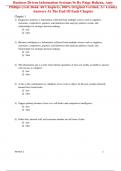Business Driven Information Systems 9e By Paige Baltzan, Amy
Phillips (Test Bank All Chapters, 100% Original Verified, A+ Grade)
Answers At The End Of Each Chapter
Chapter 1
1) Diagnostic analytics is information collected from multiple sources such as suppliers,
customers, competitors, partners, and industries that analyzes patterns, trends, and
relationships for strategic decision making.
⊚ true
⊚ false
2) Business intelligence is information collected from multiple sources such as suppliers,
customers, competitors, partners, and industries that analyzes patterns, trends, and
relationships for strategic decision making.
⊚ true
⊚ false
3) The information age is a time when infinite quantities of facts are widely available to anyone
who can use a computer.
⊚ true
⊚ false
4) A fact is the confirmation or validation of an event or object. In the past, people primarily
learned facts from books.
⊚ true
⊚ false
5) Zappos primary business focus is to sell books and competitive intelligence.
⊚ true
⊚ false
6) Order date, amount sold, and customer number are all forms of data.
⊚ true
⊚ false
Version 1 1
,7) Choosing not to fire a sales representative who is underperforming while knowing that the
representative is experiencing family problems is a form of knowledge.
⊚ true
⊚ false
8) Information is data converted into a meaningful and useful context. The truth about
information is that its value is only as good as the people who use it. People using the same
information can make different decisions depending on how they interpret or analyze the
information.
⊚ true
⊚ false
9) The fourth industrial revolution represents the blending of the digital, physical, and
biological worlds with rates of change operating at hypervelocity.
⊚ true
⊚ false
10) The fifth industrial revolution represents the blending of the digital, physical, and biological
worlds with rates of change operating at hypervelocity.
⊚ true
⊚ false
11) The Internet of Things (IoT) is any device connected to the Internet with the goal of
enhancing performance without human intervention.
⊚ true
⊚ false
12) Machine-to-machine (M2M) refers to two or more connected devices interacting via wireless
or wired connections with the goal of data sharing and analytics without human intervention.
⊚ true
⊚ false
Version 1 2
,13) Machine-to-machine (M2M) refers to two or more connected devices interacting via wireless
or wired connections with the goal of data sharing and analytics depending on having human
intervention to complete the transactions.
⊚ true
⊚ false
14) The Internet of Things (IoT) refers to devices that are unable to connect directly to other
devices.
⊚ true
⊚ false
15) Environmental data captures environmental data including annual carbon emissions and
energy consumption, water usage, waste, pollution output, etc.
⊚ true
⊚ false
16) Social data captures environmental data including annual carbon emissions and energy
consumption, water usage, waste, pollution output, etc.
⊚ true
⊚ false
17) Social data captures statistics related to workforce diversity, gender equity, human rights, etc.
⊚ true
⊚ false
18) Governance data captures statistics related to workforce diversity, gender equity, human
rights, etc.
⊚ true
⊚ false
Version 1 3
, 19) Governance data captures company data regarding corruption, labor practices, gender
composition of the board of directors, etc.
⊚ true
⊚ false
20) Predictive analytics extracts information from data and uses it to predict future trends and
identify behavioral patterns.
⊚ true
⊚ false
21) Top managers use predictive analytics to define the future of the business, analyzing markets,
industries, and economies to determine the strategic direction the company must follow to
remain profitable. Tony will set the strategic direction for his firm, which might include
introducing new flavors of potato chips or sports drinks as new product lines or schools and
hospitals as new market segments.
⊚ true
⊚ false
22) A data analyst collects, queries, and consumers organizational data to uncover patterns and
provide insights for strategic business decision making.
⊚ true
⊚ false
23) Using only data and information to make decisions and solve problems is the key to finding
success in business. These are also the only core drivers of the information age and the
building blocks of business systems.
⊚ true
⊚ false
24) Big data represents large volumes of data - both structured and unstructured - containing
greater variety, increased veracity, and with more velocity.
⊚ true
⊚ false
Version 1 4




